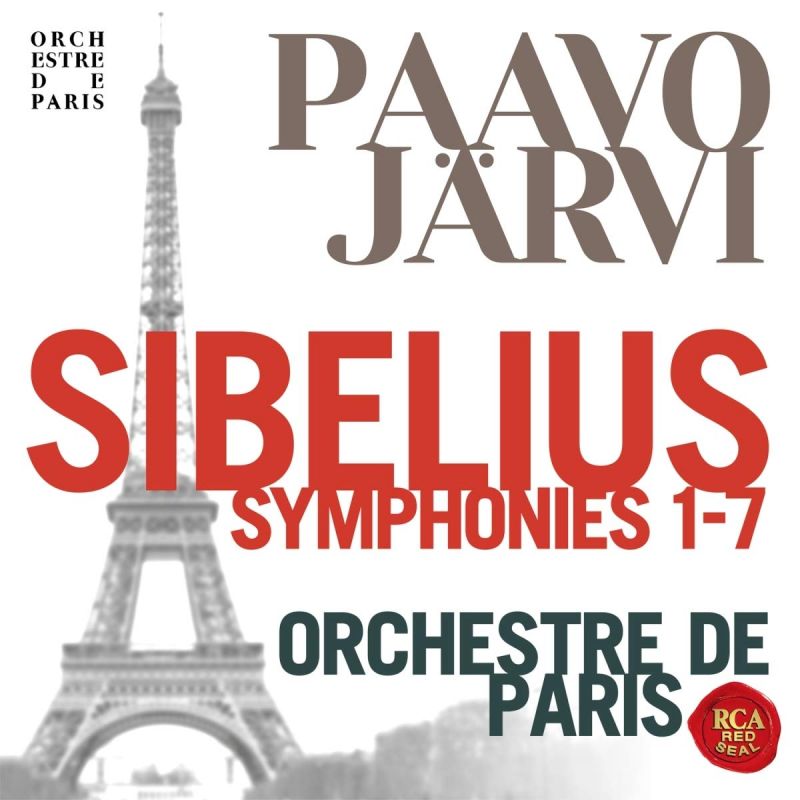SIBELIUS Complete Symphonies (Järvi)
View record and artist detailsRecord and Artist Details
Composer or Director: Jean Sibelius
Genre:
Orchestral
Label: RCA Red Seal
Magazine Review Date: 03/2019
Media Format: CD or Download
Media Runtime: 232
Mastering:
DDD
Catalogue Number: 19075 92451-2

Tracks:
| Composition | Artist Credit |
|---|---|
| Symphony No. 1 |
Jean Sibelius, Composer
Jean Sibelius, Composer Orchestre de Paris Paavo Järvi, Composer |
| Symphony No. 2 |
Jean Sibelius, Composer
Jean Sibelius, Composer Orchestre de Paris Paavo Järvi, Composer |
| Symphony No. 3 |
Jean Sibelius, Composer
Jean Sibelius, Composer Orchestre de Paris Paavo Järvi, Composer |
| Symphony No. 4 |
Jean Sibelius, Composer
Jean Sibelius, Composer Orchestre de Paris Paavo Järvi, Composer |
| Symphony No. 5 |
Jean Sibelius, Composer
Jean Sibelius, Composer Orchestre de Paris Paavo Järvi, Composer |
| Symphony No. 6 |
Jean Sibelius, Composer
Jean Sibelius, Composer Orchestre de Paris Paavo Järvi, Composer |
| Symphony No. 7 |
Jean Sibelius, Composer
Jean Sibelius, Composer Orchestre de Paris Paavo Järvi, Composer |
Author: Andrew Mellor
You can hear that love in these live performances from a lustrous, characterful orchestra at the Salle Pleyel and latterly the Philharmonie de Paris. Very little is substandard, nothing is library choice, the playing is bold and the lack of interpretative baggage can be refreshing. Culturally speaking, Järvi’s Estonia is the closest place to Finland on earth and the conductor tells of how much the music means to him. It might be down to orchestra, rather than conductor, that these performances are distinctly less Nordic in feel than the same conductor’s recordings of non-symphonic Sibelius from Stockholm.
By ‘Nordic’ I mean, in one sense, the culture of buttoning emotions up until they explode out, which is both interpretative and textual – subconscious and consciously strived for. Much of the time Järvi’s climaxes feel less like breakthroughs than they do from others (his dad, Vänskä, Storgårds, Colin Davis), whether because the build-up is drawn out or too emphatic (finale of No 1, latter quarter of No 7), because the ratio of fire to ice tips towards the former (No 2, second movement), or because you occasionally feel the hand of the conductor at work (No 7, the string hymn). There are plenty of caressing interventions from Järvi that reveal his vision of this as European Romantic music, even if some of the big tunes (finales of No 2 and No 3) aren’t consciously phrased as that viewpoint would suggest they might be.
Nor have these musicians laid to rest the unanswerable question of whether Sibelius’s figurations are material or accompaniment. Great Sibelius performances have a way of placing all that patterning in a near-but-far hinterland so it can appear neither one nor the other – and, therefore, both at the same time – but the Orchestre de Paris often present it as if on a platter (Symphony No 6, 2'30" into the first movement, and Symphony No 7 at 14 bars before the Adagio). That can cause problems further down the line when the miracle of the writing depends on the mysterious combination of levels of activity and what emerges in between them. Rhythmic subtleties are occasionally papered over (Sibelius’s sectional ragging at 2'15" and 4'30" in the first movement of No 5) and sometimes you feel Järvi has worked hard to find a tempo that works for this front-footed orchestra but that it serves structure less well than it does immediate sonority. What suffers is sureness of direction and a sense of absolute inevitability.
In No 3, perhaps the finest performance here (and one of the later recordings, from March 2016), the orchestra comes closest to letting itself be carried by Sibelius’s symphonic river, while in the Sixth and Seventh (recorded two years earlier) I feel the playing is too generally emphatic to convey a gravitational force and we come close to losing the line, especially in the latter, which gets bogged down. On the flipside, Järvi proves excellent at sustaining tension through the whiteouts of No 4 with help from an orchestra whose string tone has a sheen that can sound as ominous as it does luxurious (this was the last to be recorded).
The assiduously deployed grandeur in that performance isn’t always an asset elsewhere. It can skew balance in No 3 and No 6, contributing to the idea that it’s possible to prepare climaxes too far back in the score and meaning we sometimes miss the sense of strain in the writing. Solos can be a little showy, not least the trombone in No 7 (certainly not traced) and a vibrato-laden flute elsewhere. Yet the sound of the full ensemble itself, well recorded, remains distinct and impressive. In some of these masterpieces’ most important pages, you can fault the preparation but not the thrilling sound Järvi gets from his orchestra in the moment.
Discover the world's largest classical music catalogue with Presto Music.

Gramophone Digital Club
- Digital Edition
- Digital Archive
- Reviews Database
- Full website access
From £8.75 / month
Subscribe
Gramophone Full Club
- Print Edition
- Digital Edition
- Digital Archive
- Reviews Database
- Full website access
From £11.00 / month
Subscribe
If you are a library, university or other organisation that would be interested in an institutional subscription to Gramophone please click here for further information.




